Now, 39 years later, on a beautiful Sunday morning, I am sitting in another 1960 VW Microbus very much like that first one. It belonged to my friend Darrell Pinckney who died on April 22nd. I am honored and privileged to be driving it to the 13th Annual Volkswagens on the Green. For the second year, our club (Volkswagen Enthusiasts of Colorado) is hosting this event at Clement Park.
The first thing I notice is how small the cab area is. It is not a question of leg or head room since these are adequate for me. However, the windshield seems right in my face and there is a feeling of being extremely vulnerable. Only a thin sheet metal panel separates the tips of my toes from the outside world. My knees straddle the steering column. In fact the manufacturer wisely suggested that if a head on collision was anticipated the driver and front passenger should lift their legs to minimize injury. Back in the days when I was making the scene in my 1960 there were numerous horror stories about people taking their VW Microbusses north up the Alcan Highway, getting into collisions in remote areas and losing their legs at the knee. I began to have visions of an entire string-town colony of refugees who looked like Toulouse-Lautrec living in blasted out VW Busses along the road from Dawson Creek to Fairbanks.
The cab was designed to maximize cargo space and is quite utilitarian. I remember that it is similar in some respects to the cockpit of a small airplane of the same era. I am now used to modern vehicles with adjustable seats and dashes that curve away from the driver and have bodies that extend beyond. I drive big over the road trucks sometimes and this vehicle is on the opposite end of the spectrum. It suddenly occurs to me that a contributing factor to the feeling of confinement is being 50 pounds heavier than in 1968. Still I like the car and find it satisfying to be inside.
Yesterday afternoon, Tim (Darrell’s son) and I spent a few hours cleaning up the bus and doing some minor repairs. It was hot. I stabbed myself in the thumb putting on some personalized license plate brackets while Tim struggled trying to install window seals. We both tried to figure out how much fuel was in the tank. Darrell was a scientist and kept notes on all of his vehicles. According to his mileage figures, there should be ample fuel remaining for the distance I would travel. On the other hand I didn’t want to risk running out. The knob for the reserve fuel was stuck. When I finally got it free, it pulled out with about 8” of cable so I knew it was disconnected. I went to get fuel in a couple of lawn mower sized plastic gas cans. The gas leaked inside the trunk of my wife’s car on the way back saturating the carpet. When I poured the fuel in the bus I found the spouts on both cans didn’t seal and the path of least resistance was down the side forming a puddle around my feet. The angle I had to hold the container caused the leakage to worsen. I found a funnel, but the tip was too short so it actually made the situation worse. After getting maybe a couple of gallons in the tank, I said to Tim: “You know Darrell is probably laughing his ass off at us right now”. He agreed.
I did feel his gentle presence. He was sitting in his chair, there on the porch, watching us. He slowly puffed on his pipe and the pleasurable smell drifted out to me. There was a mischievous twinkle in his eyes. I felt he was about to make a witty comment or perhaps a sarcastic remark about my competence. All I heard in my head was a soft “thank you” and “bye, bye” the way Darrell always ended our phone conversations. In reply I said: “No. Thank you!”
I start the bus and leave it in neutral idling while I transfer some club stuff for the show.
Every time I get out and take a few steps the engine dies. I check and find the choke is disconnected. After loading, I restart the engine and just sit there nursing the throttle awhile. I like the old familiar sound that resonates along the floor and permeates straight into my body and soul, filling me with a pleasurable nostalgia. I put it in gear and move off. Darrell has a tachometer, but I just use the original speedometer shift points and that works pretty well. I find that when I am in top gear and let off the throttle it jumps out with a disconcerting bang. Lightly resting my hand on the shifter solves the problem. I remember an old friend in California that had a similar bus with an identical problem. He fashioned a stick with a notch that fit the shifter and it was wedged against the parcel tray to keep the transmission from popping out of fourth when cruising. About five years later he showed up at our place in Sedalia unannounced for a visit. He had the same bus with the same un-repaired transmission except, now, his stick had two notches because it jumped out of third and fourth gears.
The other minor problem I am having with Darrell’s is when I need to get into first the shift lever moves so far to the left that it traps my leg against the steering column. Pushing the stick down and back to get into reverse is worse. However, I find that, with a little jockeying and shifting of position, I am able to shift OK. With the sliders open, I thoroughly enjoy my leisurely drive to Clement Park. After parking Darrell’s bus for awhile by our club’s pavilion so our members could see it, Tim took it over to the Colorado Bus Club. This is a group that Darrell traveled and camped with for years. Tim and his sister Sue set up a nice display with memorabilia and photographs from Darrell’s past.
At the end of the show, awards are handed out. A trophy was given in remembrance of Darrell and it is our intention to make this an annual award.

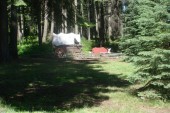
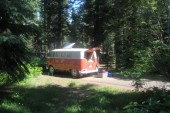
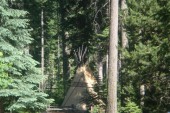
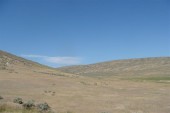
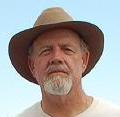
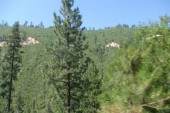
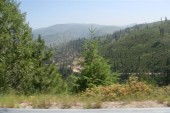
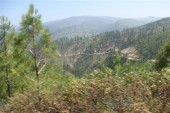
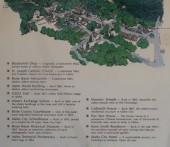


 Facebook
Facebook Twitter
Twitter